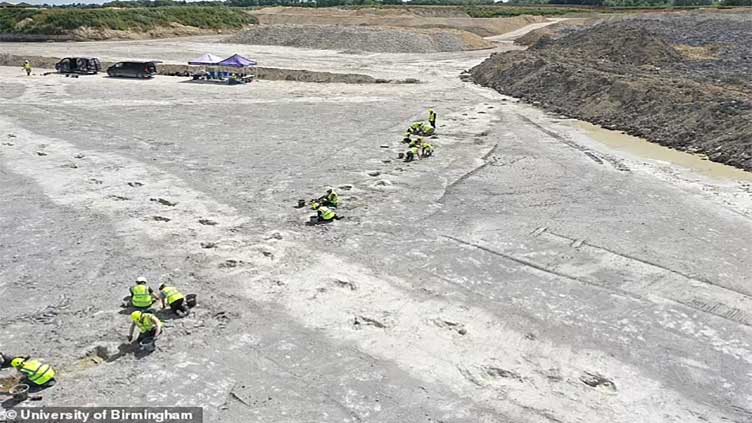Biggest dinosaur footprint site discovered from 166 million years

Technology
Full-scale excavation of the site began
(Web Desk) - Just a few hundred metres from the roaring traffic of the M40, scientists have uncovered a very different kind of road.
Around 166 million years ago Britain's 'dinosaur highway' was teaming with lumbering giants and fierce predators making their way across the country.
Researchers from the Universities of Oxford and Birmingham have uncovered a huge expanse of quarry floor filled with hundreds of different dinosaur footprints.
Scientists found five of the UK's most extensive dinosaur trackways, with the longest measuring 150m in length.
Four of these belong to long-necked herbivores - most likely Cetiosaurus, an 18-metre-long cousin of the Diplodocus.
The fifth track was made by a passing Megalosaurus, a ferocious nine-metre-long predator which stalked the boggy lagoons of Britain during the Middle Jurassic period.
These uniquely well-preserved tracks reveal some stunning insights into the lives of the long-extinct giants, even recording the moment two dinosaurs crossed paths.
And researchers say it is 'very likely' that there are still more tracks to be found.
The tracks were found in the Jurassic limestone of the Dewars Farm Quarry in Oxfordshire.
Originally buried under clay, these new tracks were first spotted by quarry worker Gary Johnson when he felt 'unusual bumps' while stripping back the clay to reach the quarry floor.
Realising the significance of the find, experts were contacted and a full-scale excavation of the site began.
During June last year, more than 100 scientists and volunteers carefully uncovered over 200 fossilised footprints.
In addition to making casts of the prints for further study, the researchers also took more than 20,000 photographs to create a complete 3D model of the site.
This discovery connects to earlier finds made in the area in 1997 when a previous limestone quarry uncovered more than 40 tracks from sauropods and theropods, a group of bipedal dinosaurs including the Tyrannosaurus Rex.
However, the site was buried before the widespread use of digital cameras and drones so no 3D models of the tracks could be made.
That means this latest discovery is an especially valuable insight into a vibrant prehistoric ecosystem.



